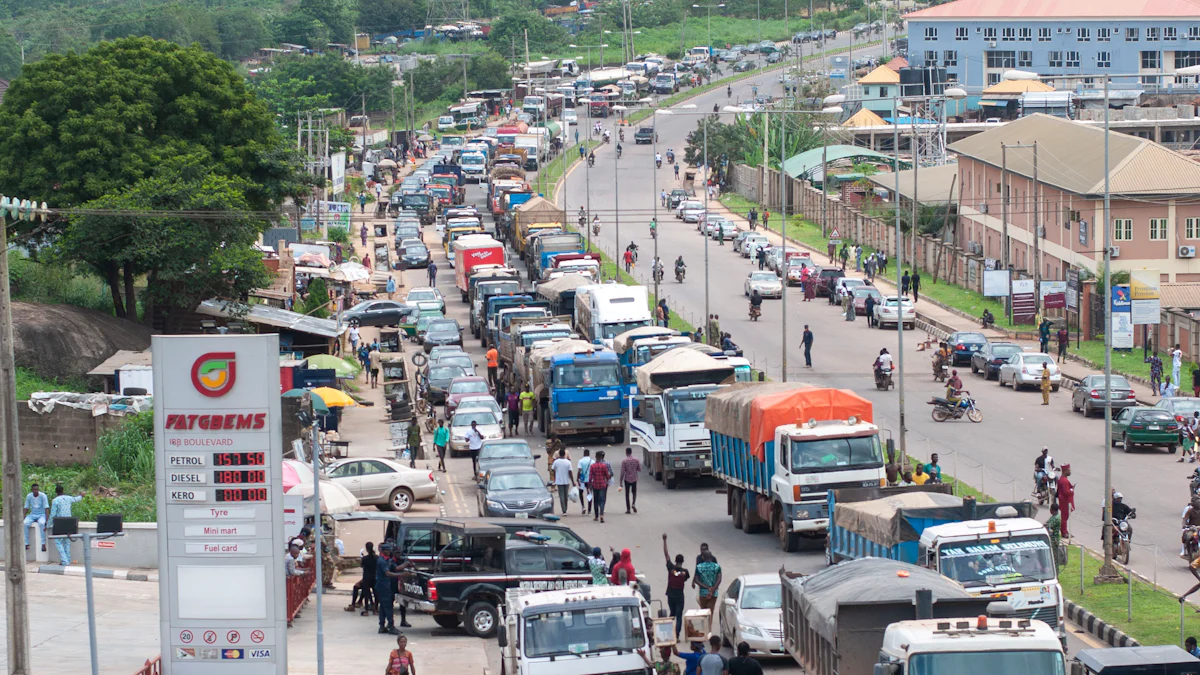Advantages and Disadvantages of Land Transport in International Shipping

International shipping plays a crucial role in global trade. Over 80% of goods move by sea, highlighting the importance of maritime transport. However, Land Transport serves as a vital link in the logistics chain. Trucks and trains connect producers, markets, and consumers. This blog will explore both the advantages and disadvantages of using land transport in international shipping.
Advantages of Land Transport in International Shipping

Cost-Effectiveness
Lower Fuel Costs
Land Transport often proves more economical due to lower fuel costs. Trucks, for instance, consume less fuel compared to airplanes or ships over short distances. Rail transport also stands out for its fuel efficiency. Trains can move a ton of freight over four times further on a gallon of fuel than trucks. This efficiency translates into significant cost savings, especially for long-haul routes.
Reduced Handling Charges
Handling charges tend to be lower with Land Transport. Trucks and trains can load and unload cargo directly at the origin and destination points. This reduces the need for multiple handling stages, which often incur additional costs. Fewer handling stages also minimize the risk of damage to goods, leading to potential savings on insurance and repair costs.
Flexibility and Accessibility
Door-to-Door Service
One of the standout features of Land Transport is its ability to offer door-to-door service. Trucks can pick up goods directly from the producer and deliver them straight to the consumer. This eliminates the need for intermediate transfer points, making the process more streamlined and efficient. Such flexibility is particularly beneficial for smaller shipments that require quick and direct delivery.
Versatility in Cargo Types
Land Transport offers remarkable versatility in handling various types of cargo. Trucks and trains can transport everything from perishable goods to heavy machinery. Specialized vehicles and railcars can accommodate different cargo requirements. This adaptability makes Land Transport a preferred choice for diverse shipping needs.
Speed and Reliability
Shorter Transit Times for Short Distances
For short distances, Land Transport often provides quicker transit times. Trucks can travel directly from point A to point B without the need for lengthy loading and unloading processes. This direct route ensures faster delivery times, which is crucial for time-sensitive shipments.
Consistent Schedules
Land Transport generally offers more consistent schedules. Trains and trucks operate on fixed routes and timetables, reducing the likelihood of delays. This reliability helps businesses plan their logistics more effectively, ensuring that goods arrive on time.
Disadvantages of Land Transport in International Shipping

Limited by Geography
Inaccessibility to Remote Areas
Land Transport often struggles with reaching remote areas. Trucks and trains need well-maintained roads and railways. Many regions lack this infrastructure. For example, the Incas' system of interconnected roads in the pre-Columbian era showed the limitations of Land Transport due to geography. Modern logistics face similar challenges. Remote areas remain hard to access, limiting the reach of Land Transport.
Dependence on Infrastructure
Infrastructure plays a crucial role in Land Transport. Roads and railways must be in good condition. Poor infrastructure can lead to delays and increased costs. The Silk Road connected distant economies and cultures, demonstrating the importance of overcoming geographical boundaries in land trade. Today, many regions still struggle with inadequate infrastructure. This dependence makes Land Transport less reliable in some areas.
Environmental Impact
Carbon Emissions
Land Transport contributes significantly to carbon emissions. Trucks and trains burn fossil fuels, releasing CO2 into the atmosphere. This impacts the environment negatively. Efforts to reduce carbon footprints include using electric vehicles and improving fuel efficiency. However, the current reliance on fossil fuels remains a major concern.
Noise Pollution
Noise pollution is another issue with Land Transport. Trucks and trains generate significant noise levels. This affects both urban and rural areas. Noise pollution can disturb wildlife and human communities. Efforts to mitigate noise include better vehicle design and sound barriers. Despite these measures, noise pollution remains a challenge.
Regulatory and Border Issues
Customs Delays
Customs delays pose significant problems for Land Transport. Crossing borders involves various checks and paperwork. These processes can slow down shipments. Delays at customs can disrupt supply chains and increase costs. Businesses must account for these potential delays when planning logistics.
Varying Regulations Across Countries
Different countries have different regulations for Land Transport. These varying rules can complicate international shipping. Compliance with multiple regulations requires careful planning and coordination. Differences in safety standards, vehicle requirements, and documentation can create obstacles. Navigating these regulatory landscapes adds complexity to Land Transport.
Land Transport in international shipping offers several benefits. Lower fuel costs and reduced handling charges make it cost-effective. Door-to-door service and versatility in cargo types add flexibility. Shorter transit times for short distances and consistent schedules enhance reliability. However, limitations exist. Inaccessibility to remote areas and dependence on infrastructure pose challenges. Environmental impacts like carbon emissions and noise pollution remain concerns. Regulatory and border issues complicate logistics.
Land Transport continues to play a crucial role in connecting producers, markets, and consumers. Future developments may include sustainable innovations and improved infrastructure. These advancements could address current limitations and enhance efficiency.
See Also
Revealing the Latest in Sea Freight Logistics for 2024
Unraveling the Effects: Trends in Logistics Risks
Unveiling the Definitive Global Logistics Companies Guide
A Comprehensive Look into the Future of LTL Freight
Ready for the Future? Investigating the Latest in Supply Chain Transport Tech
